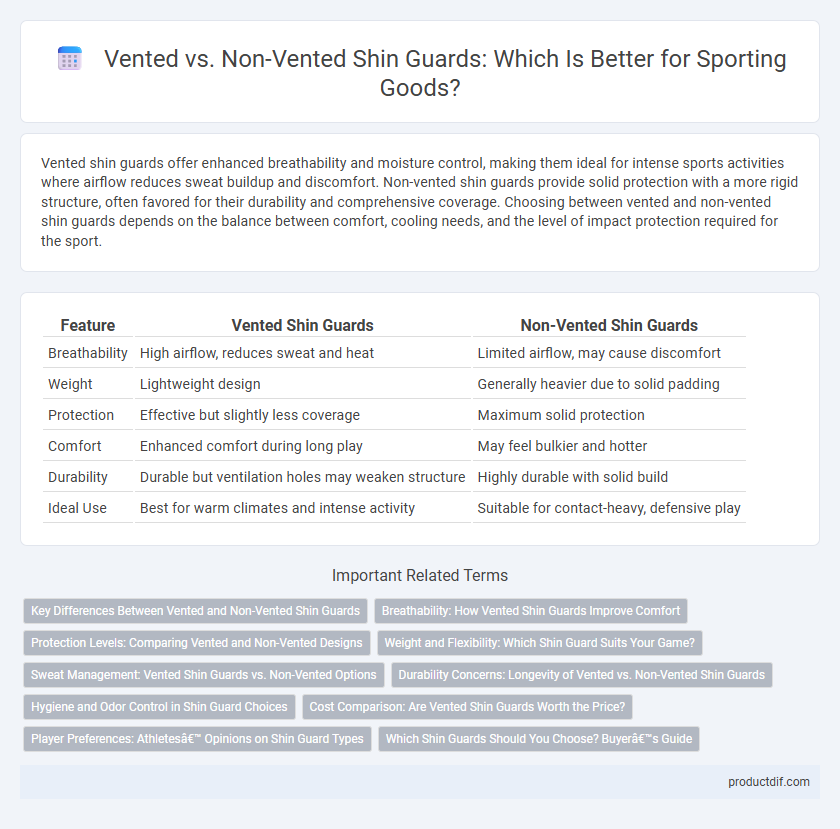Vented shin guards offer enhanced breathability and moisture control, making them ideal for intense sports activities where airflow reduces sweat buildup and discomfort. Non-vented shin guards provide solid protection with a more rigid structure, often favored for their durability and comprehensive coverage. Choosing between vented and non-vented shin guards depends on the balance between comfort, cooling needs, and the level of impact protection required for the sport.
Table of Comparison
| Feature | Vented Shin Guards | Non-Vented Shin Guards |
|---|---|---|
| Breathability | High airflow, reduces sweat and heat | Limited airflow, may cause discomfort |
| Weight | Lightweight design | Generally heavier due to solid padding |
| Protection | Effective but slightly less coverage | Maximum solid protection |
| Comfort | Enhanced comfort during long play | May feel bulkier and hotter |
| Durability | Durable but ventilation holes may weaken structure | Highly durable with solid build |
| Ideal Use | Best for warm climates and intense activity | Suitable for contact-heavy, defensive play |
Key Differences Between Vented and Non-Vented Shin Guards
Vented shin guards feature strategically placed perforations to enhance breathability and reduce sweat buildup during intense physical activity, improving overall comfort. Non-vented shin guards provide a solid, continuous surface which offers slightly better protection against impacts and debris but can cause increased heat and moisture retention. The choice between vented and non-vented shin guards depends on prioritizing ventilation and lightweight comfort versus maximum protection and durability.
Breathability: How Vented Shin Guards Improve Comfort
Vented shin guards feature strategically placed airflow channels that significantly enhance breathability, reducing heat and moisture buildup during intense physical activity. Non-vented shin guards tend to trap sweat and heat, leading to discomfort and increased risk of skin irritation. Improved ventilation in vented shin guards ensures athletes maintain optimal comfort and focus, especially during prolonged sports sessions.
Protection Levels: Comparing Vented and Non-Vented Designs
Vented shin guards offer enhanced breathability and moisture control but may compromise on impact resistance compared to non-vented models, which provide a solid protective shell without airflow. Non-vented shin guards typically feature a denser foam padding and a rigid outer layer that maximizes protection against forceful impacts during high-contact sports. Athletes prioritizing maximum protection in aggressive gameplay often prefer non-vented shin guards despite potential heat buildup, making them suitable for positions with frequent physical challenges.
Weight and Flexibility: Which Shin Guard Suits Your Game?
Vented shin guards offer superior breathability and reduced weight, enhancing agility and comfort during intense gameplay, while non-vented models typically provide more rigid protection but can be heavier and less flexible. Athletes prioritizing speed and mobility benefit from vented designs due to their lightweight materials and airflow features that prevent overheating. Players seeking maximum impact resistance may prefer non-vented shin guards despite the trade-off in weight and flexibility.
Sweat Management: Vented Shin Guards vs. Non-Vented Options
Vented shin guards enhance sweat management by allowing airflow through strategically placed perforations, reducing moisture buildup and promoting faster drying during intense physical activity. Non-vented shin guards, lacking these air channels, tend to trap sweat and heat, which can lead to discomfort and increased risk of skin irritation or bacterial growth. Athletes seeking improved hygiene and comfort often prefer vented models for superior breathability and moisture control.
Durability Concerns: Longevity of Vented vs. Non-Vented Shin Guards
Vented shin guards offer enhanced breathability but may have reduced durability due to thinner padding and exposed mesh areas that wear out faster under intense use. Non-vented shin guards feature solid, thick shells providing superior impact resistance and longer lifespan, making them ideal for players prioritizing protection and endurance. Choosing between vented and non-vented depends on balancing airflow needs with durability requirements for sustained performance.
Hygiene and Odor Control in Shin Guard Choices
Vented shin guards feature breathable materials and strategically placed vents that enhance airflow, significantly reducing sweat buildup and minimizing odor-causing bacteria. Non-vented shin guards lack these airflow channels, often resulting in increased moisture retention and a higher risk of unpleasant odors and skin irritation. Choosing vented shin guards supports better hygiene and prolonged freshness during intense sports activities.
Cost Comparison: Are Vented Shin Guards Worth the Price?
Vented shin guards often come at a higher price point due to advanced materials and enhanced breathability compared to non-vented models, making them a premium option for athletes prioritizing comfort and performance. Non-vented shin guards provide effective protection at a lower cost but may trap heat and moisture during intense activity. Evaluating the cost difference involves balancing budget constraints with the value of increased ventilation and reduced sweat buildup for prolonged use in sports like soccer and hockey.
Player Preferences: Athletes’ Opinions on Shin Guard Types
Athletes often prefer vented shin guards for their enhanced breathability, which reduces sweat buildup and improves comfort during intense play. Non-vented shin guards are favored by players seeking maximum protection and durability, as their solid design offers a sturdier shield against impacts. Player preferences vary based on position and playing style, with forwards and midfielders leaning toward vented models for agility, while defenders prioritize non-vented guards for increased defense.
Which Shin Guards Should You Choose? Buyer’s Guide
Vented shin guards offer enhanced breathability and moisture control, making them ideal for athletes seeking comfort during intense sports activities. Non-vented shin guards provide superior protection by being made of denser materials, suited for players prioritizing maximum defense. Choose vented models for better airflow and reduced sweat buildup, or select non-vented guards for increased durability and impact resistance based on your specific sporting needs.
Vented shin guards vs Non-vented shin guards Infographic

 productdif.com
productdif.com